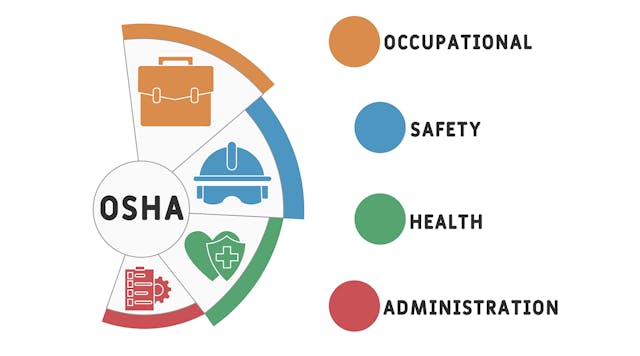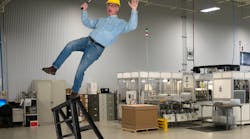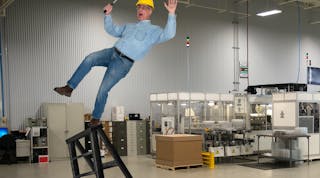Safety and maintenance challenges in manufacturing are as old as the industry itself.
But they're not just logistical headaches; they're issues that could be the difference between life or death. That's why connected worker technology is such a game-changer. We're talking about technology that lets workers, managers and even machines talk to each other in real time.
This article outlines practical strategies for integrating connected worker technology into your plant’s operations to enhance real-time communication and safety measures.
1. Faster Response with Real-time Communication
Picture this: A machine overheats or spews toxic fumes. A worker spots the issue, leaves to tell a supervisor and waits for action. With every minute that passes, the risk of a safety event increases.
But with connected worker technology, sensors on the machine not only spot the problem but also enable supervisors to remotely shut it off. As demonstrated in the Owens Corning R.O.C.K.E.T. program, smart glasses and cameras were used for real-time interactive support, allowing on-site personnel to collaborate with remote experts for immediate problem resolution. This response alerts both workers and supervisors through wearables or smartphones, ensuring that resolution starts within seconds, thereby reducing damage and preventing injury.
Expanding beyond immediate incident responses, connected worker technology revolutionizes the broader scope of data-driven decision-making, empowering supervisors to make informed choices in real time. Supervisors instantly receive data on equipment health, environmental conditions and even worker fatigue. This helps you act swiftly and wisely in the best interest of everyone’s safety.
Here’s are considerations for implementing, and sustaining, real-time communication:
- Review current systems: Spot the weak links in your existing communication methods, such as inaccurate (or incomplete) data transfer and delayed response times, e.g., the lag in communication between the field and the control room or management.
- Talk to frontline workers: They’ll be using this technology every day. Their feedback—and buy-in— is essential for a smooth roll-out.
- Pick the right technology: Whether it’s wearables or a solid mobile app, the tools and systems you choose need to integrate with your existing setup.
- Train everyone: Once you pick a tool, thoroughly train staff to ensure everyone’s up to speed.
- Keep adapting: As technology evolves, so should your safety measures. Stay updated on new technologies that can make communication even faster.
Immediate, data-rich and team-based communication is a must-have for a safety game plan.
2. Enhanced Worker Training and Skill Development
Remember those bulky manuals and printouts you used to distribute to your employees? They're often outdated before they even hit the printer. Now, your team can pull up the latest training materials right on their tablets or mobile devices. Whether they're troubleshooting machinery or following a new safety rule, help is just a swipe away.
Hands-on training is irreplaceable, but instant video guides are an additional safety tool. Your workers can pull up step-by-step tutorials to help them with complex tasks or learn new equipment. Quick access to help cuts down on the potential for them to make mistakes, which could put their safety at risk.
Another benefit of electronic training materials is the ability to customize them based on skill levels and roles. That way, veteran workers don’t have to spend time learning the basics, and newcomers get the essential training they need. Virtual training also ensures that all employees get a periodic refresher and recommit to safety protocols, especially as new best practices emerge. This results in a team that's more skilled and safer on the job without any unnecessary downtime for employees.
To take your worker training to the next level, there are several actionable steps you can follow:
- Review current materials: Identify what you have and what needs to be digitized or updated for easy access.
- Tap into worker expertise for content: Who better to guide a tutorial than someone who’s been doing the task for years? Collect video tips from your pros. As a bonus, calling out employees for doing things right will bolster pride and morale.
- Set role-specific access: Streamline the process by only providing workers with material that’s directly relevant to their jobs.
- Analyze and adjust: Use metrics to see how well your training modules are working and tweak them based on real outcomes. This can also help you personalize your efforts if employees aren’t completing their training or need some additional support.
- Set timely reminders: Take advantage of dashboard tools that allow you to send reminders for recurring training or certifications, ensuring that everyone is current on training. This is also evidence to OSHA that the company is striving to be compliant.
These steps will make your training more efficient, targeted and effective, ensuring a safer and more skilled workforce.
3. Proactive Equipment Maintenance and Monitoring
Connected worker technology takes equipment upkeep to the next level by swapping reactive fixes for proactive care. Forget waiting for scheduled checks or equipment breakdowns. With Internet of Things (IoT) sensors on your equipment, you can keep tabs on key metrics, such as temperature and vibrations. This real-time data streams to a central dashboard, letting you catch issues before they become problems.
Nobody likes unexpected downtime because it’s bad for work and worse for safety. Connected worker platforms send real-time alerts straight to your team so they can nip issues in the bud, allowing production to continue without catastrophic interruption.
When workers get live data on the machines they’re running, they take ownership and address issues proactively. This boosts both accountability and proactive care.
Connected worker technology also aggregates your machine data into a single snapshot of your equipment’s health. Now, you're not just guessing or following a set schedule—you're making data-backed decisions about what needs attention, according to the device itself.
4. Better Compliance with Safety Regulations
Gone are the days of rummaging through binders or enduring endless meetings for regulatory updates. With connected technology, up-to-date safety rules are just a swipe away on your device. This can be attributed to both the ease with which safety professionals can push out updates, and the capability of safety technology to automatically update; as soon as regulators or companies make an update, the system automatically integrates these changes and makes them instantly accessible to workers. Workers can quickly and easily refer to them and make smart, compliant choices as they go.
Oversight is key, and real-time monitoring lets you stay on top of potential issues. Spot any safety deviations? You can step in before they escalate into actual problems.
Filling out compliance reports can be tedious but connected technology makes it less onerous. Its data capture features let you generate reports quickly, helping you stay prepared in the event of internal audits and any legal challenges.
Here are the steps for enabling easy access to safety rules and active monitoring:
- Continuous compliance evaluation: Initiate an ongoing process of evaluating your internal protocols. This continual assessment helps identify areas of improvement and ensures alignment with evolving safety standards, fostering a culture of continuous safety enhancement.
- Digitize for accessibility: Transition all safety protocols and checklists into a digital format. This not only makes them easily accessible through connected technology but also allows for quicker updates and distribution.
- Comprehensive training: Expand on training to include not just usage but also best practices for leveraging technology in maintaining safety standards.
- Proactive oversight: Emphasize the proactive aspect of real-time monitoring, detailing how this technology can predict potential compliance issues before they occur.
- Dynamic updates: Focus on the dynamic nature of regulations and the ability of your system to adapt swiftly, ensuring that all safety information is not just current but also anticipates future changes.
Real-time access and oversight make compliance not just easier, but part of your plant's DNA.
5. Boosted Worker Accountability and Responsibility
Old-school paperwork can be a deterrent, but connected technology simplifies incident reporting. With a few taps, workers can instantly log safety issues, paving the way for swift action.
The data collected from incident reports doesn't just accumulate—it's actively analyzed. Frequent data analysis helps identify problematic trends or specific areas in need of improvement. By addressing these issues proactively, you can enact safety measures that prevent incidents rather than merely reacting to them.
When workers see their actions as part of a larger picture, they're more likely to think twice and act responsibly. They see themselves not just as cogs in a machine, but as active participants in a broader safety ecosystem. This empowerment translates to higher adherence to safety protocols and a greater sense of ownership over their responsibilities.
Implement the following actionable steps for accountability:
- Simplify reporting: Use technology features that create a straightforward incident logging system.
- Regular briefings: Use data to keep everyone in the loop about safety trends and needed improvements.
- Acknowledge good behavior: Reward responsible actions to reinforce a culture of safety.
- Open feedback channels: Let workers offer safety suggestions through a centralized platform.
- Train for accountability: Host workshops stressing the link between individual actions and overall safety.
By taking these steps, connected worker technology shifts safety from being a page in a manual to a living part of your manufacturing plant's ethos.
Leveraging Technology for a Safer, and Healthier, Work Environment
Imagine a workspace where safety rules aren’t just shoved into a drawer but live right in everyone's pocket. Picture a plant where employees make decisions based on hard data, not gut feelings. Imagine a workplace culture where following the rules is just how things are done, and where everyone invests in keeping things safe.
This transformation isn’t just an upgrade; it’s a workplace safety revolution. It’s time to invest in implementing technology that takes care of your most crucial asset: your people.
Eric Whitley is the director of smart manufacturing at L2L, a provider of connected workforce solutions.










































































